4 Mar 2014
Our first event for 2014 was the Professional Horticulture Group South West Conference held at Bridgwater College, Cannington on 12 February entitled 'Managing Green Space in a Time of Austerity'. Three excellent speakers had been assembled for this meeting and a brief report of their talks appears below.
Congratulations to Prof Geoff Dixon who has been made an Honorary Member of the International Society for Horticultural Research, one of only five UK members to be so honoured.
This month we may not be following the now established pattern of a Plant of the Month and a Medicinal Plant of the Month. Inspired (?) by the recent inundations, we have picked a terrestrial plant of the month and an aquatic plant of the month (with a twist….)
Editor
Managing Green Space in a Time of Austerity
The Cannington Conference held each February has now become a welcome fixture in the Professional Horticultural Growers South West (PHGSW) calendar. This year Prof Geoff Dixon had assembled three speakers to answer the challenge of 'Managing Green Space in a Time of Austerity'. The speakers were;
Nick Wray, Curator of the Bristol University Botanic Garden who has had the additional challenge of moving the garden to a new site. (see also Newsletter July 2011)
Iain Park, Director of Grounds at Exeter University who has to manage a university campus where building work is a regular feature of the landscape.
Chris Evans, Nursery manager at Bournemouth Parks who, after a career spanning art and design, the Royal Navy (including service in the Falklands) and a period as a computer programmer, finally retrained in horticulture.
Although all three had very different remits to fulfil a common theme emerged - the importance of selling - ensuring that the decision makers in the respective university or council appreciated the value of green space to the organisation. In Nick Wray's case his initial challenge was to ensure that the university felt the need for a Botanic Garden at all. This entailed not just convincing them of the need but also defining quite clearly its purpose and focus.
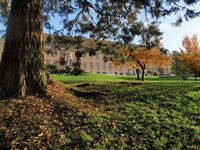
All three had met this aim by first and foremost providing good horticulture to argue with and then fostering relations with the managers above. In each case this argument was backed up by ensuring the profile of the horticulture was regularly publicised in ways that the managers could appreciate.
Equally important to convincing the paymasters is generating a sense of the gardens belonging to the town and its people. Chris Evans has used his art and design background to design award-winning displays at Chelsea, Hampton Court and Tatton Garden shows. These not only act as great publicity for the town but also a much appreciated photo opportunity for the administrators to be pictured with the trophy as well as something the townspeople can be proud of.
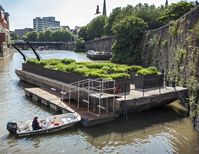
Iain Park has to be more subtle in his approach although university administrators do appreciate being able to greet visitors who have already been softened by the pleasant gardens they pass to reach the buildings. A particular problem he faces is the appearance of building sites within the campus. In addition to forward planning to mitigate the impact of such development, he has also created a 'Mitigation Squad' to immediately rectify any damage that may occur while the contractors and authorities argue fault and liability.
The result in all three examples is gardens that have the full support of their respective authorities as well as being appreciated by the townspeople.
Terrestrial Plant of the Month
Musa acuminata (AAA group) 'Gros Michel'

In the late 19th century, a few entrepreneurs began to export bananas from the tropics to the United States and Europe. Though an astounding number of banana varieties exist in the world, the export industry centred on one cultivar: Gros Michel. Very few of the world's banana varieties are hardy and consistent enough to withstand the rigours of international shipping; the Gros Michel had the necessary characteristics, and furthermore, it was delicious.
Soon after bananas caught on in the United States and Europe, a mysterious malady began to devastate plantations in Panama. Dubbed Panama disease or mal de Panamá in Spanish, the pathology was caused by the fungus Fusarium oxysporum f.sp. cubense. It was virulent and relentless; for the entire first half of the 20th century, producers played a cat-and-mouse game with the fungus, and the cat won.
As a desperate last-minute solution, growers switched from the Gros Michel to the only trade-ready variety known to be resistant to Panama disease: the Cavendish (pictured). Though the resistance of Cavendish was common knowledge in the banana world, producers were reluctant to switch to this banana due to its relative lack of flavour. By 1960, substitution was complete, and to this day, we are still eating the bland Cavendish.
Though commercial production of the Gros Michel was wiped out, the banana is not extinct. It is still grown for small-scale local consumption in parts of the tropical world. Supported by a Wallace Watson Award from St Catherine's College, Oxford, I undertook a five-week expedition to Costa Rica and Panama to learn about bananas, work with banana researchers and farmers, locate a disease-free Gros Michel plant, and send a cutting back to England to be planted ultimately in the display collections at Oxford Botanic Garden.
I acquired the plant from the germplasm bank of an agronomy institution called CATIE (Centro Agronómico Tropical de Investigación y Enseñanza) in Turrialba, Costa Rica. It is the product of in vitro meristem propagation, a method that ensures disease-free plant tissue. The material from which it was propagated was collected from farmers in the mountainous Turrialba area, where locals still eat Gros Michel bananas regularly. They grow Cavendish bananas primarily to feed pigs.
It's hoped that the exhibition of this plant will educate visitors about an event that nearly wiped out the world's favourite fruit, unbeknownst to most of its consumers; perhaps it will also inspire them to give more thought to the food they eat. For most residents of developed countries, food seems to simply appear in grocery stores, conveniently packaged and reliable.
There is more at stake, though, than the relation of an interesting narrative. A new strain of Panama disease has appeared recently in Asia, and not even the Cavendish is resistant this time. However, awareness of the impending threat and funding for initiatives against it are both startlingly scant.
The banana is the world's fourth most important staple crop, behind wheat, rice, and maize. A banana crisis could have catastrophic implications for the economic and nutritional security of millions worldwide. If history repeats itself, it is likely to do so with more force than in the first epidemic. Awareness is an important prophylactic.
Appreciate your bananas, not only because of work that goes into getting them across the ocean, but also because they may not be around forever.
Myles Karp, (MSc Cognitive and Evolutionary Anthropology) St Catherine's College, Oxford University
Aquatic Plant of the Month
Villarsia capensis, Menyanthaceae, Cape Bogbean
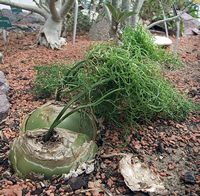
A few years ago, seed of the plant Bowiea volubilis (pictured ) was requested from a particular Index Seminum. This interesting plant in the Hyacinthaceae (now Asparagaceae) is a bulbous, succulent, scrambling plant from the deserts of South Africa.
The seeds arrived, were sown, and germinated very successfully. They were grown on, planted out in specialist xerophyte compost and nurtured by the glasshouse horticultural team. One day, the team were asked to plant the plants out into the arid house as they were flowering and of sufficient size for display. A chance remark by one of the horticultural team, 'They're very thirsty for arid house plants' led to the team looking at the flowering plants more closely.
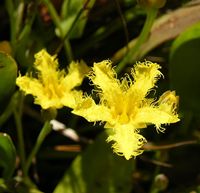
On closer inspection, the flowers (pictured right) clearly belonged to a typical 'dicot' rather than a typical 'monocot' - there were five petals rather than three, the leaves had reticulate veins rather than parallel veins and so on.
The next stage was to 'key' out the plant, but this did not result in a new identity - mainly as we discovered later because we were answering the key question incorrectly. The crucial piece of information we had wrong? This was an aquatic plant, not a terrestrial one! What we actually had was Villarsia capensis, an aquatic plant from South Africa, rather than Bowiea volubilis, a succulent from South Africa (pictured right).
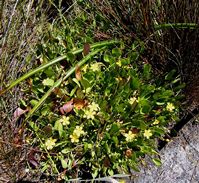
Alison Foster
Oxford Botanic Garden
Horticulture Industry News
For the very latest horticultural news follow us on Facebook,
Twitter, or
LinkedIn
Revolutionary view on heritability in plants
Scientists have shown that epigenetic 'marks' (non-genetic features that attach to DNA and modify their effect) can affect traits such as flowering time and architecture in plants. Furthermore, these marks are passed on for many generations in a stable manner. It seems that a revision of genetics textbooks is now in order.
We've all been taught that DNA is the physical foundation of heredity. The fact that the functioning of our genes is also affected by epigenetic marks has been known for decades. What is now clear is that in plants these non-genetic characters can be inherited through many generations. More
Plant diversity is bad for leafhoppers
Understanding how changes in plant diversity affect agroecosystem functioning remains a key challenge. Researchers examined how intercropping alfalfa, Medicago sativa, with orchardgrass, Dactylis glomerata, affected the potato leafhopper, Empoasca fabae, its host plant (alfalfa), and the efficiency of a leafhopper predator, Nabis americoferus.
In a field experiment, intercropping reduced the reproductive efficiency of the leafhopper. Nabis was more effective at reducing leafhopper abundance, and protecting alfalfa from hopper-burn, in the polyculture than in the monoculture of alfalfa. The orchardgrass, a nonhost for leafhoppers, increased leafhopper movement, and Nabis captured leafhoppers more efficiently when the herbivores were more mobile. More
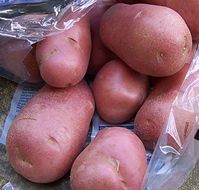
As scientist await approval to grow Desiree potatoes (pictured right) genetically modified to resist potato blight (Phytophthora infestans) a new kind of resistance has been indentified based on the protein LecRK-I.9 and operates on the outside of the plant cell. This is new, because the resistance used so far to help potatoes withstand Phytophthora recognises unwanted intruders in the plant cell.
But this kind of resistance is relatively easy to circumvent because Phytophthora mutates rapidly and can therefore avoid being recognised. Researchers came across LecRK in Arabidopsis, the model plant often use for research. They demonstrated earlier that this protein plays a role in the resistance of Arabidopsis to plant diseases. Then they placed LecRK in potatoes and demonstrated that these potatoes have an increased resistance to Phytophthora.
Hormone transport in plants deciphered
A major group of plant hormones, cytokinins, originate in the roots of plants, and their journey to growth areas on the stem and in leaves stimulates plant development. The molecular mechanism responsible for their transportation within plants was previously poorly understood. Now, a study has identified the protein (AtABCG14 protein) essential for relocating cytokinins from roots to shoots.
Cytokinins stimulate shoot growth and promote branching, expansion and plant height. This study may open new avenues for modifying various important crops, agriculturally, biotechnologically, and horticulturally, to increase yields and reduce fertiliser requirements. More
A grass roots approach to flooding
Large areas of the UK are facing continued and widespread threats from flooding. Many of our river catchments are upland grasslands predominating in the wettest areas of the UK. If the rates of surface run-off could be reduced and rainfall captured more effectively by grassland soils, then the worst impacts of heavy rainfall down-stream might be reduced.
The BBSRC SUREROOT project builds on earlier BBSRC-funded research where it was reported that a forage grass hybrid known as Festulolium and designed originally for livestock agriculture, also held a hidden underground and previously unknown property. The large well developed root systems of Festulolium combat flooding, reduce soil erosion and compaction and offer opportunities for significant carbon capture and storage at depth in soils.
Their grass root-soil interactions instigated a change in soil structure leading to increased water retention with a prolonged and significant 51% reduction in rainfall run-off compared with equivalent grasses that were grown alongside and that are currently used extensively throughout the UK. More
Tree Roots Regulate CO2
Scientists have discovered that the great arbiters of long-term global temperatures may not be the leaves of an oak, pine or eucalyptus, but the roots. The argument, put forward begins with temperature. Warmer climates mean more vigorous tree growth and more leaf litter, and more organic content in the soil. So the tree's roots grow more vigorously. They get into the bedrock, and break up the rock into its constituent minerals.
Once that happens, the rock starts to weather, combining with carbon dioxide. This weathering draws carbon dioxide out of the atmosphere, and in the process cools the planet down a little. So mountain ecosystems - mountain forests are usually wet and on conspicuous layers of rock-are in effect part of the global thermostat, preventing catastrophic overheating.
The tree is more than just a sink for carbon, it is an agency for chemical weathering that removes carbon from the air and locks it up in carbonate rock. More
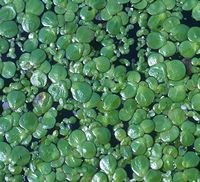
The genome of Greater Duckweed (Spirodela polyrhiza picture right) has given this miniscule plant's potential as a biofuel source a big boost. Researchers detailed the complete genome of S. polyrhiza and analysed it in comparison to several other plants, including rice and tomatoes.
Simple and primitive, a duckweed plant consists of a single small kidney-shaped leaf that floats on the surface of the water with a few thin roots underwater. It grows in almost all geographic areas, at nearly any altitude. It's among the fastest growing plants, able to double its population in a couple of days under ideal conditions.
These and other properties make it an ideal candidate as a biofuel feedstock - a raw source for biofuel production. For example, unlike plants on land, duckweeds don't need to hold themselves upright or transport water from distant roots to their leaves, so they're a relatively soft and pliable plant, containing tiny amounts of woody material such as lignin and cellulose.
Removing these woody materials from feedstock has been a major challenge in biofuel production. Also, although they are small enough to grow in many environments, unlike biofuel-producing microbes, duckweed plants are large enough to harvest easily. More
Sniffed out - the 'gas detectors' of the plant world
The 'master regulators' that control the detection of nitric oxide (NO) by plants and which regulate many important aspects of plant growth and response to environmental stress have been found . Plants fine-tune their growth and survival in response to various signals, including internal hormones and external factors such as light or temperature.
Nitric oxide gas is one such signal. In plants, NO regulates many different processes throughout the plant's lifetime from seeds to flowering and responses to the environment. Although the effect of NO on plants has been known for many years, a general mechanism for the initial sensing of this important molecule has remained elusive. We have identified a small number of key proteins, called transcription factors, which act as 'master sensors' to control NO responses throughout the plant life cycle.
The mechanism by which these NO sensor regulatory proteins perceive and respond directly to gaseous signals is not only elegant but also opens promising avenues for future research. A specific structure at the beginning of these proteins means that they are rapidly degraded in the presence of NO. However, when NO is absent they become stable, resulting in changed growth and development. More
Molecular caliper determines hormone reaction in plants
The plant hormone auxin seems to work wonders for plant growth. The development of roots and the vascular system, the growth of plants towards light; there are hardly any growth processes that do not need this hormone. For a long time it was a mystery as to how this chemically simple molecule managed all that.
Now a research group has described how molecular switches shaped like a caliper make sure unique hormonal reactions take place in various parts of the plant. The hormone auxin switches a large number of genes on and off. Special proteins, the Auxin Response Factors (ARF), bind to DNA and are essential for this switching process. There are 23 different ARF proteins and researchers found that each binds at two sites. Acting like a caliper it is the distance between these two binding site that makes all the difference.
Blackcurrant 'may ease asthma'
A laboratory study in New Zealand, which tested blackcurrant extracts on human lung cells in culture has shed some light on the complex immune responses to allergens, in particular those associated with inflammation of lung tissue seen in some asthma attacks. However, as this was a laboratory study on extracted cells, it is too soon to know whether the type of exposure these lung cells had to the blackcurrant extracts equates to how the body may access them after consumption of blackcurrants.
While the findings may help explain why diets high in some fruits seem to reduce the incidence and prevalence of asthma, it remains to be seen which exact chemical reactions may be responsible. It is also not yet clear whether the substances tested can be purified and turned into a safe and effective form of treatment for asthma.
Events Calendar
Precision Irrigation Conference
6 Mar, UK Irrigation Association
Peterborough, UK
Vegetable Grafting
17 - 19 Mar, International Society for Horticultural Science
Wuhan, China
From Concept to Exit - 'Good Business Planning'
19 Mar, InCrops
Harpenden, UK
New Ag International
26 - 28 Mar, New Ag International
Warsaw, Poland
Physiological Principles and Their Application to Fruit Production
26 - 28 Mar
Geneva, USA
UK PlantSci 2014
31 Mar - 1 Apr, UK Plant Science Federation
York, UK
Pollinators in Agriculture
1 - 3 Apr, Association of Applied Biologists
Brussels, Belgium
The Genus Lilium
1 - 3 Apr, International Society for Horticultural Science
Zhangzhou, China
Trees, People and the Built Environment
2 - 3 Apr, Chartered Institute of Foresters
Birmingham, UK
Global Berry Congress
7 - 9 Apr, Eurofruit
Amsterdam, The Netherlands
Wild Relatives of Subtropical and Temperate Fruit and Nut Crops
7 - 12 Apr, Wild Relatives of Subtropical and Temperate Fruit and Nut Crops
Baku, Azerbaijan
Investment for business growth - the legal side explained
11 Apr, InCrops
Harpenden, UK
Natural & Organic Products Europe
13 - 14 Apr, Diversified Communication
London, UK
Sulfur Metabolism in Plants
14 Apr, Institut für Forstwissenschaften
Freiburg, Germany
Advances in Cider Technology
16 Apr, Association of Applied Biologists
Pershore, UK
Plant Genomics Conference
12 - 13 May, Global Engage
London, UK
Brassica Conference
15 May, UK Brassica Research Community
Wellesbourne, UK
Loquat Symposium
12 - 15 May, International Society for Horticultural Science
Palermo, Italy
Society of Biology AGM
15 May
London, UK
Plant Chemical Biology
16 May, Agrinet
Jealotts Hill, UK
If you would like to advertise a forthcoming event please contact. ester.monfort@soci.org
Horticulture Group Contact Details
For submitting ideas or to volunteer to be part of a committee or a group, please contact:
Chairman - Peter Grimbly
Meetings Secretary - Alison Foster
Minutes Secretary - Margaret Waddy
Newsletter co-ordinator - Sue Grimbly scihortigroup@btinternet.com
Group Contact - Ester Monfort Martinez, E: ester.monfort@soci.org T: +44(0)20 7598 1584
